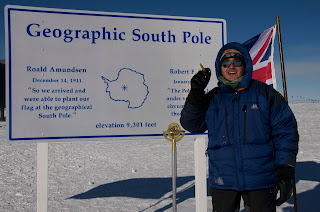Quarrying the Antarctic for climate
In 1773, Captain Cook described the great southern continent Terra Australis Incognita as ‘A country doomed by nature never once to feel the warmth of the sun’s rays but to lie forever buried under everlasting snow and ice’. But is it? We used to think of Antarctica being completely insulated from the rest of the world, effectively stuck in an ice age which most of the planet finished with 12,000 years ago. Disturbingly, there are signs that the image we’ve conjured up in our minds of a frozen continent is fast disappearing. Across this vast region, the last few decades has seen trends above and below the ice that are far from encouraging. Warming has been observed across large parts of the continent and it seems most probable its down to our high-energy lifestyles that has seen us flood the atmosphere with carbon.
Unfortunately, Antarctica’s connection to the rest of the world means this special part of the world is not immune to rising greenhouses in the atmosphere. As the planet warms, the atmosphere and ocean are driving large changes across the continent. Some parts have warmed massively compared to the rest of the world. Most prominently, air temperatures over the Antarctic Peninsula have increased by 2.5 °C since the 1950s. This is four times the global average which for a frozen landscape can only mean trouble. Under these conditions, the Larsen B Ice Shelf on the eastern side of the Peninsula impressively fell away into the sea in just 31 days during one heady month in 2002. Warming led to pooling of the meltwater on the surface, which found its way down through cracks and broke up the Shelf. For something the size of Rhode Island that had been stable for 12,000 years, it was something of a wake up call.
 |
| We even made it to the Pole for the centenary of Scott's arrival! Thanks to ALE. |
 |
| Almost as far as you can get! |
In January 2012, Chris Fogwill and I will be undertaking scientific exploration of the Patriot Hills, part of Antarctica’s Ellsworth Mountains. Based at the University of New South Wales (Australia), funded by the Australian Research Council and working with Antarctic Logistics and Expeditions (ALE), we’ll be working in an average temperature of -20˚C. This is an even more challenging environment than the one we worked in last year. The high winds at Patriot Hills, which average more than 25km/hr, scour the surface of snow, exposing the blue ice below. Fortunately, however, these high winds can work in our favour. The winds are so fast and dry, the ice at the surface is removed by a process known as sublimation, drawing ancient, compressed snowfall up from down below. The practical upshot is this process exposes a wonderfully accessible, detailed record of past climate change preserved in millennia-old ice that allows you to literally walk back through time. Instead of coring for past climate, we'll be working across the surface (and against the elements!) to collect this precious archive. The idea is this will produce the first climate reconstruction for the region over the last twelve thousand years. By extending ‘historical’ records of the last few decades, we hope we’ll gain a better understanding of how Antarctic ice sheets respond to past and future change. At least that’s the plan...
The timetable for our fieldwork can be found at www.christurney.com. If you fancy following us more closely, we’ll be twittering away on ProfChrisTurney during our Antarctic fieldwork, describing the conditions and progress of work in the traditional 140 characters or less. Hope you can join us.


Comments
Post a Comment